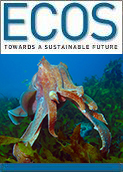
|
Published: 30 September 2013
Giant cuttlefish conundrum
Nestled in the apex of South Australia’s Spencer Gulf, Point Lowly is noteworthy for its historic lighthouse, a small sandy beach and a view of Port Bonython’s hydrocarbon processing plant. Just offshore, the rocky sea floor has a very different reputation. It’s where a unique population of the world’s largest cuttlefish gathers to spawn.
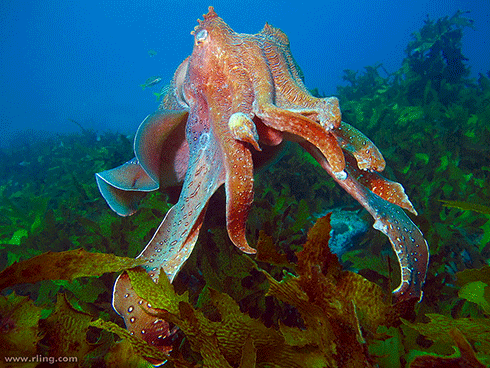
|
|
Cephalopod with charisma: The giant Australian cuttlefish can turn on the charm and colour. Credit:
Richard Ling via flicker under CC BY-NC-ND 2.0
|
Nobody would confuse one for the mighty Kraken, but the giant Australian cuttlefish (Sepia apama) is nonetheless a monster amongst molluscs. In some populations off Australia’s eastern coast, its mantle length can exceed half a metre, while the animal’s mass has been recorded at a hefty 12 kilograms.
While the weight of animals in the Point Lowly population rarely exceeds a kilogram, it’s their sheer numbers during winter spawning that has drawn scientists, recreational divers and tourists to this spot since the phenomenon was first documented in the 1990s. The giant cuttlefish may be endemic to much of the southern Australian coastline, but Point Lowly’s population is unique in exhibiting this annual event. At a density of one cuttlefish per square metre, in full psychedelic sexual display (males) or mating or egg-laying, the spectacle is nature at its most brilliant.
Over the past decade, however, population numbers have declined, dropping by an estimated 90 per cent from around 183 000 individuals in 1999 to 18 530 in 2012. The latest surveys in the area have shown the decline has continued from 2012 to 13 500 individuals in 20131, although the rate of decline appears to have slowed down from previous years.
Researchers aren’t sure why the numbers have declined. The Spencer Gulf is a cul-de-sac piercing South Australia’s heartland, bringing the interests of fisheries, conservation and industry into close quarters, highlighting their different perspectives. For example, overseas laboratory-based studies have found that in other species, their statocysts – structures needed for balance and position – can be seriously compromised by high-intensity, low-frequency sounds. Thus acoustic trauma from increased shipping is one of the speculated risks for Sepia apama, but shipping is essential to the area’s economic development.
Speculation also surrounds any change in salinity in the gulf. Currently, water extracted from the Great Artesian Basin supplies local industry such as mining. Future expansion of industrial activity might require additional water to be supplied from a desalination plant on Upper Spencer Gulf.
A 2009 environmental impact study identified the risk of altered pH and salinity on the cuttlefish, stating ‘[t]he maintenance of a suitable environment for the Sepia apama aggregation near Point Lowly is paramount to retaining this unique mass aggregation event, and the subsequent Spencer Gulf population.’
What the scientists see
So what is behind the giant cuttlefish’s drop in numbers? Professor Bronwyn Gillanders from the School of Earth and Environmental Sciences at the University of Adelaide says the cause of the population decline is likely due to a number of factors.
And the lack of detailed information on the long-term patterns of the cuttlefish’s breeding population makes the task of identifying the causal factors more difficult, according to Prof Gillanders.
‘They could have increased in abundance, and they could be going back to what their normal levels were. That could be one possibility, but we have little evidence indicating one way or another.
‘There is suggestion in the early eighties, when the Santos oil refinery went in, there were no cuttlefish observed, but by 1986 there were certainly cuttlefish observed.’
Whether there is a cycle remains a valid question – an article in the Adelaide Advertiser in 1910 mentions ‘an alleged accumulation of cuttlefish in a decomposed condition lying on the esplanade’. Similarly in September 1947, a report in The Mail mentions that dead cuttlefish had covered beaches ‘so thickly that walking is made uncomfortable’.
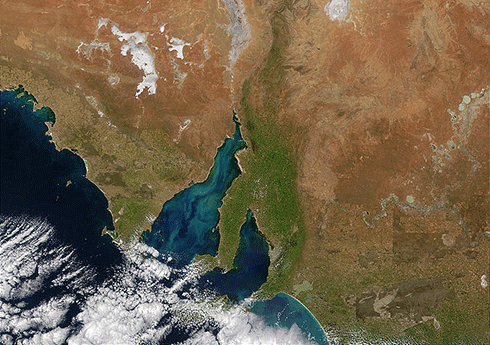
|
|
Spencer Gulf (left) pierces SA’s heartland, bringing the interests of fisheries, conservation and industry into close proximity. Credit:
NASA
|
A preliminary desktop review conducted over the past few years by SA Research and Development Institute (SARDI) has explored the potential for factors such as environmental irregularities, increased predation pressure, industrial pollution and fishing pressure to have played some role in their decline.
While the research has provided avenues for further study, the big picture of what has been happening to the cuttlefish aggregation remains unclear.
Reconciling interests
In 2012, a report prepared for the SA Department of Environment, Water and Natural Resources (DEWNR) highlighted how the upper reaches of the Spencer Gulf could potentially be developed for heavy industry. With mining worth $5 billion to the state, cities surrounding Point Lowly, such as Whyalla and Port Pirie, could provide critical platforms for expanding mining projects.
The forecast that if the area’s resources potential were fully realised, shipping in the area could more than double, from just under 400 vessel movements per year to 1000-plus by 2020.
DEWNR has been trying to tackle the giant cuttlefish issue for some years. In 2006, it commissioned a draft marine plan for the area, which would have required there to be ‘negligible impacts’ on the cuttlefish breeding habitat at Point Lowly peninsula.
Chris Thomas, manager of the Marine Parks Project in SA’s Department of Environment, Water and Natural Resources, says in 2007 the state government decided that, rather than continue the marine planning program initiated in 2006, it would consolidate the diversity of marine programs by focusing on a more streamlined marine parks network. This saw an end to the 2006 draft plan in favour of management that took into account diverse state interests.
He added that the policy commitments outlined in a 2012 independently prepared environmental impact statement for the Upper Spencer Gulf ‘recognise the need to achieve both conservation and sustainable use outcomes and were agreed by the Government to inform the development of each marine park management plan’.
Competing values between conservation and state economics are evident in how Point Lowly’s surrounding marine environment is currently managed. ‘The management plan also recognises the importance of this area to the economic development of the state,’ Chris says, ‘as it also provides for development activities.’
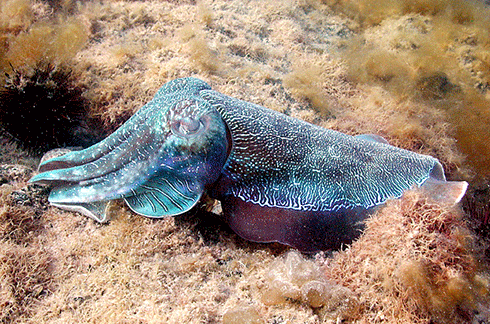
|
|
Is the Point Lowly population a distinct species of giant cuttlefish? Credit:
Sean Connell/University of Adelaide
|
The South Australian Government is also taking measures to protect the cuttlefish population from human impact. In March this year, a 12-month fishing closure on Sepia apama extended fishing laws that had been implemented around Point Lowly since 1998. In addition, $200 000 has been committed by the state government to research the cuttlefish and monitor the population’s numbers, as well as investigate other potential aggregations sites in Spencer Gulf and the potential use of artificial reefs as a protection measure.
Research is now under way to determine the movement patterns and population structure of the cuttlefish in northern Spencer Gulf, and assess and evaluate the response of the cuttlefish population to environmental and human factors. This project – led by researchers from the University of Adelaide, in partnership with SARDI, the South Australian Museum, and PIRSA – is funded by the Fisheries Research and Development Corporation (FRDC) and DEWNR.
University of Adelaide researchers, in partnership with SARDI and the EPA, are also investigating the potential impacts of shipping on giant cuttlefish in response to expected increases in shipping in the Spencer Gulf region, a project funded by the former Commonwealth Department of Sustainability, Environment, Water, Population and Communities (now Department of the Environment).
One significant outcome of current research could be the reclassification of Point Lowly’s Sepia apama as a distinct species in its own right. While giant cuttlefish numbers around the Australian coast remain healthy, different populations don’t interbreed, leaving the Point Lowly group genetically isolated.
‘The genetic evidence that we have suggests that it’s definitely a distinct population, but whether the boundary of that population has changed over time is another question,’ says Professor Gillanders. ‘We’re currently doing more work that will hopefully resolve the taxonomic status of the species.’
If the Point Lowly giant cuttlefish were scientifically recognised as a separate species, this might have implications for its conservation at state and Commonwealth levels. For example, the Commonwealth Environment Protection and Biodiversity Conservation Act 1999 (EPBC Act) protects matters of national environmental significance, affording protection to listed species threatened over their national extent, rather than to threatened populations of a species that is otherwise secure. Thus if the giant cuttlefish were recognised as a separate species, it could be nominated for assessment as a threatened species under the EPBC Act.
For the moment, however, the decline of the giant Australian cuttlefish represents more than a biological mystery – the issue highlights the competing values of the enviroment and economic development. Whether Australia’s diminutive Kraken returns to Point Lowly in high numbers remains to be seen.
More information
|
University of Adelaide researchers are calling on the public to help them find out more about the giant cuttlefish and its recent decline. |
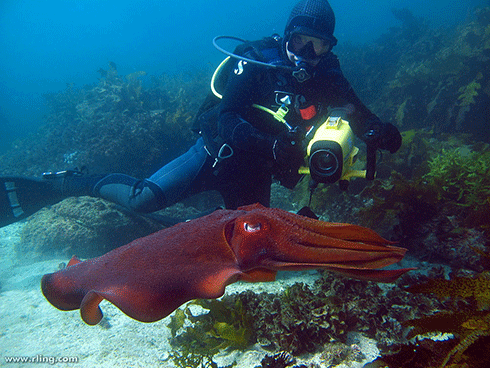
Divers, fishers and others out on Spencer Gulf are asked to record sightings of cuttlefish and eggs via the ‘redmap’ site. Credit: via flicker under CC BY-NC-ND 2.0
|
‘As part of this new project, we are asking fishers, divers, boaters and others to report any sightings of cuttlefish and their eggs, especially in the northern Spencer Gulf,’ said Prof Gillanders. |
‘Sightings will help determine if the cuttlefish are moving elsewhere to breed and how the distribution and abundance of the population might be changing. The dispersal of hatchlings away from the spawning site and location of sub-adults is currently unknown. |
‘If [the Point Lowly population is a separate species], there is an even greater imperative to identify the factors behind the decline, and to see if any particular stages of the cuttlefish are more vulnerable than others.’ |
Members of the public are asked to record sightings of individuals (numbers and size) and eggs via the ‘redmap’ site. |
1 Cuttlefish Population Survey (2013) Annual diver-based survey conducted in May, June and July 2013.


